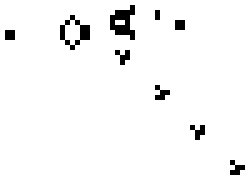Ecosyste.ms: Awesome
An open API service indexing awesome lists of open source software.
https://github.com/fraserpage/the-game-of-life-the-game
John Conway's Game of Life but a Game
https://github.com/fraserpage/the-game-of-life-the-game
Last synced: about 2 months ago
JSON representation
John Conway's Game of Life but a Game
- Host: GitHub
- URL: https://github.com/fraserpage/the-game-of-life-the-game
- Owner: fraserpage
- Created: 2021-05-28T02:12:57.000Z (over 3 years ago)
- Default Branch: main
- Last Pushed: 2021-06-07T17:13:32.000Z (over 3 years ago)
- Last Synced: 2024-07-19T06:32:21.684Z (6 months ago)
- Language: JavaScript
- Size: 608 KB
- Stars: 0
- Watchers: 1
- Forks: 0
- Open Issues: 0
-
Metadata Files:
- Readme: README.md
Awesome Lists containing this project
README
# The Game of Life: The Game
## Background
> [The Game of Life](https://en.wikipedia.org/wiki/Conway%27s_Game_of_Life), also known simply as Life, is a cellular automaton devised by the British mathematician John Horton Conway in 1970.[1] It is a zero-player game, meaning that its evolution is determined by its initial state, requiring no further input. One interacts with the Game of Life by creating an initial configuration and observing how it evolves. It is Turing complete and can simulate a universal constructor or any other Turing machine.

The Game of Life is played on a 2-dimensional grid. Cells are either alive or dead, full or empty, and evolve according to these rules:
* If a cell is alive, it stays alive if it has either 2 or 3 live neighbors
* If the cell is dead, it comes to life if it has 3 live neighbors
## But is it a game?
What if Conway's Life were a two player turn based game? I'm honestly not too sure how well it will work but let's try.
We will assign a color to cells created by each user and add a new rule: cells take on the color of the majority of its neighbors. A user can defeat their opponent by either taking over their cells or by crowding them and causing them to die. This rule is inspired by the game described by the [Cornell Math Explorers' Club](http://pi.math.cornell.edu/~lipa/mec/lesson6.html). The rest of the game play described below is my own invention and totally untested.
The board size will be determined by the viewport size. A bigger window, a bigger board. Why not?
The 'game' is very configurable, but here's a suggested way to play:
Each player is alloted a certain number of pieces to place. They take turns putting as few or as many of them onto the board as they wish to start with and then click the 'Go' button to start the life process up.
The game is then allowed to run for a number of cycles (this number is configurable in game settings) after which the players get to place more pieces.
When neither player has any pieces left the game runs for a final cycle and then ends. The player with the most pieces remaining is the winner.
## [Play it here](https://fraserpage.github.io/the-game-of-life-the-game/)
## Screenshot

## Mockup - Draft 1

Figma document
## High level program design - Draft 1
**On initialization** we determine our starting values:
* Game board sized based on browser viewport - initialized as a 2d array
The following based on game settings
* Number of pieces per player
* Number of life cycles to run for between turns
* A scoreboard object to hold a count of each player's pieces
**On 'start'**
* Player's turn:
* If first turn, hide other player's half of the board
* Else if second to place pieces, hide other player's moves
* Player places their pieces
* Player clicks 'finish turn' - finish turn function runs
**On finish turn**
* Store moves to a 'moves' object (two moves to same square cancel each other)
* If other play need a turn, start their turn
* Else, merge moves into game board and start lifecycle
**On start life cycle**
* Iterate lifecycle counter. If counter === Number of life cycles to run for between turns: start player turn
* Run life algorithm on game board array
* Run render
* If both players out of pieces, and finished last cycle, update message board with winner message
* Else, repeat
**On render**
* Update game board
* Update scoreboard
* Update pieces remaining
* Update message board
## Road map
- [ ] Allow user to add own pattern files
- [x] v1 - Implement Conway's Life algorithm in single player mode. I want to try to figure this out on my own.
- [ ] v1.1 - I know there are more efficient ways to implement the algorithm than I am likely to arrive at on my own, so after getting my own working, do some research and upgrade it to an efficient algorithm.
- [ ] Consider stretch goal of allowing for alternate cellular automata rules when designing algorithm. Can this flexibility be coded in? Logic is interpreted from an object
- [x] v.1.5 - Two player mode, single turn mode
- [x] v.2 - Two player mode, turn based
### Nice to have features
- [ ] CSS animations for cell creation/destruction -- distinct animations for hostile takeover/destruction?
- [x] Library of cell patterns that can be dragged and dropped on to the board
### Stretch goals
- [ ] use game board action to meaningfully generate game soundtrack. The challenge is that everything happens at once.
- [x] alternate cellular automata rules
- [ ] octagon based game board variant